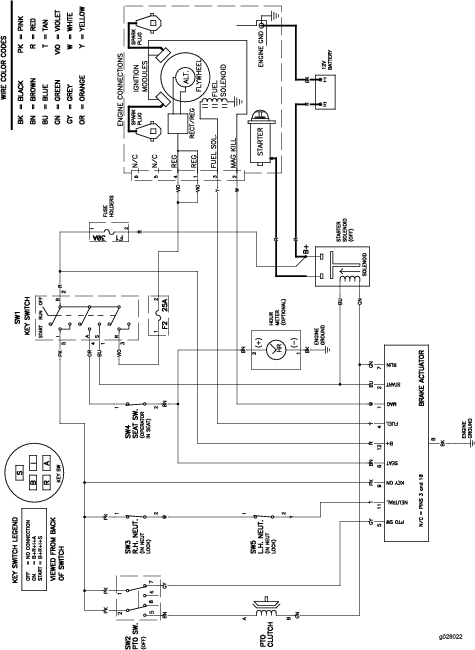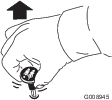| Maintenance Service Interval | Maintenance Procedure |
|---|---|
| Before each use or daily |
|
Introduction
This machine is a ride-on, rotary-blade lawn mower intended to be used by homeowners in residential applications. It is primarily designed for cutting grass on well-maintained lawns. It is not designed for cutting brush, mowing grass and other growth alongside highways, or for agricultural uses.
Read this information carefully to learn how to operate and maintain your product properly and to avoid injury and product damage. You are responsible for operating the product properly and safely.
You may contact Toro directly at www.Toro.com for product safety and operation training materials, accessory information, help finding a dealer, or to register your product.
Whenever you need service, genuine Toro parts, or additional information, contact an Authorized Service Dealer or Toro Customer Service and have the model and serial numbers of your product ready. Figure 1 identifies the location of the model and serial numbers on the product. Write the numbers in the space provided.
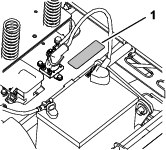
Write the product model and serial numbers in the space below:
This manual identifies potential hazards and has safety messages identified by the safety-alert symbol (Figure 2), which signals a hazard that may cause serious injury or death if you do not follow the recommended precautions.

This manual uses 2 words to highlight information. Important calls attention to special mechanical information and Note emphasizes general information worthy of special attention.
Warning
CALIFORNIA
Proposition 65 Warning
The engine exhaust from this product contains chemicals known to the State of California to cause cancer, birth defects, or other reproductive harm.
This spark ignition system complies with Canadian ICES-002
It is a violation of California Public Resource Code Section 4442 or 4443 to use or operate the engine on any forest-covered, brush-covered, or grass-covered land unless the engine is equipped with a spark arrester, as defined in Section 4442, maintained in effective working order or the engine is constructed, equipped, and maintained for the prevention of fire.
Please refer to the engine manufacturer’s information included with the machine.
Go to www.Toro.com to view specifications on your mower model.
Safety
This machine has been designed in accordance with ANSI B71.1-2012.
General Safety
This product is capable of amputating hands and feet and of throwing objects. Always follow all safety instructions to avoid serious personal injury.
Using this product for purposes other than its intended use could prove dangerous to you and bystanders.
-
Read and understand the contents of this Operator’s Manual before you start the engine. Ensure that everyone using this product knows how to use it and understands the warnings.
-
Do not put your hands or feet near moving components of the machine.
-
Do not operate the machine without all guards and other safety protective devices in place and working on the machine.
-
Keep clear of any discharge opening. Keep bystanders a safe distance away from the machine.
-
Keep children out of the operating area. Never allow children to operate the machine.
-
Stop the machine and shut off the engine before servicing, fueling, or unclogging the machine.
Improperly using or maintaining this machine can result in injury. To reduce the potential for injury, comply with these safety instructions and always pay attention to the safety-alert symbol, which means Caution, Warning, or Danger—personal safety instruction. Failure to comply with these instructions may result in personal injury or death.
You can find additional items of safety information in their respective sections throughout this manual.
Slope Indicator
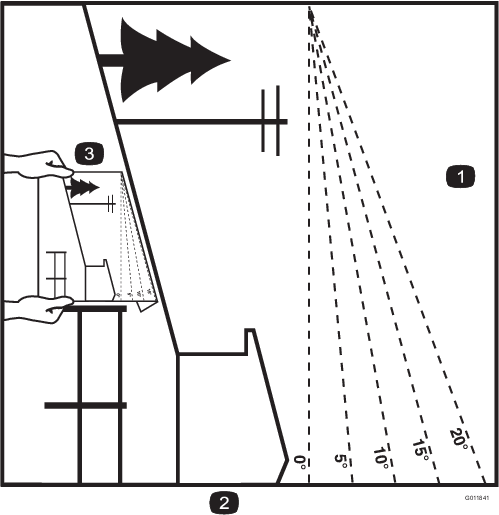
Safety and Instructional Decals
 |
Safety decals and instructions are easily visible to the operator and are located near any area of potential danger. Replace any decal that is damaged or missing. |

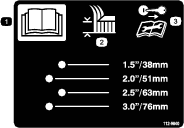
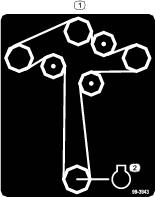
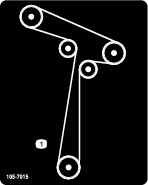






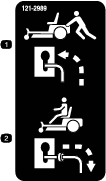
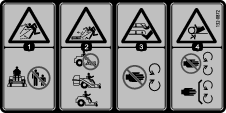

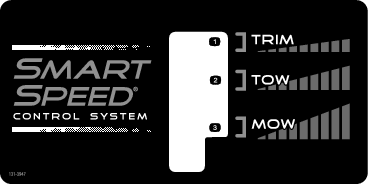
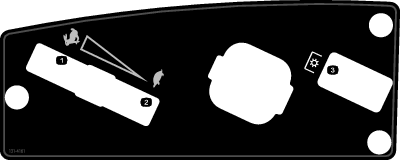
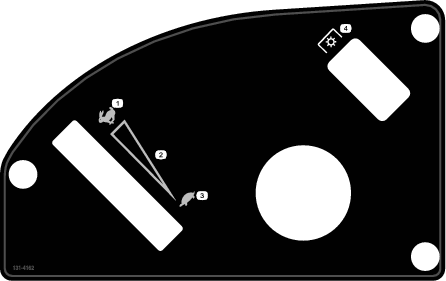
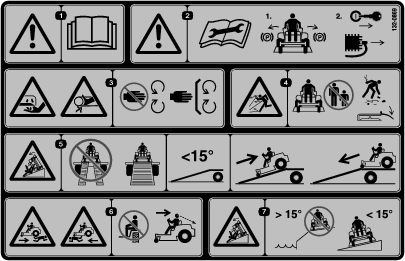
Product Overview
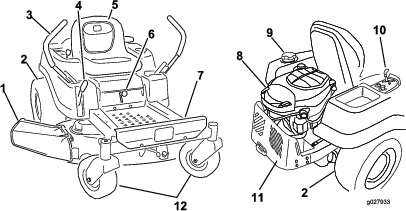
Become familiar with all the controls in Figure 4 and Figure 5 before you start the engine and operate the machine.
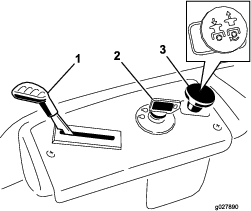
Ignition Switch
Use this switch to start the mower engine. It has 3 positions: START, RUN, and OFF.
Throttle Control
The throttle controls the engine speed, and it has a continuous-variable setting from the SLOW to FAST position (Figure 5).
Blade-Control Switch (Power Takeoff)
The blade-control switch, represented by a power-takeoff (PTO) symbol, engages and disengages power to the mower blades (Figure 5).
Motion-Control Levers
Use the motion-control levers to drive the machine forward, reverse, and turn either direction.
Park Position
Move the motion-control levers outward from the center to the PARK position when exiting the machine (Figure 18). Always position the motion-control levers into the PARK position when you stop the machine or leave it unattended.
Smart Speed
The Smart Speed™ Control-System lever, located below the operating position, gives you a choice to drive the machine at 3 speed ranges— trim, tow, and mow (Figure 21).
Fuel-Presence Window
You can use the fuel window, located on the left side of the machine, to verify the presence of fuel in the tank (Figure 6).
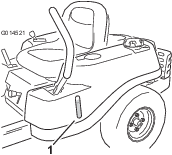
Height-of-Cut Lever
Use the height-of-cut lever to lower and raise the deck from the seated position. Moving the lever up (toward you) raises the deck from the ground and moving the lever down (away from you) lowers the deck toward the ground. Adjust the height-of-cut only while the machine is not moving (Figure 22).
Operation
Note: Determine the left and right sides of the machine from the normal operating position.
Before Operation
Before Operation Safety
General Safety
-
Never allow children or untrained people to operate or service the machine. Local regulations may restrict the age of the operator. The owner is responsible for training all operators and mechanics.
-
Become familiar with the safe operation of the equipment, operator controls, and safety signs.
-
Know how to stop the machine and shut off the engine quickly.
-
Check that operator-presence controls, safety switches, and shields are attached and functioning properly. Do not operate the machine unless they are functioning properly.
-
Before mowing, always inspect the machine to ensure that the blades, blade bolts, and cutting assemblies are in good working condition. Replace worn or damaged blades and bolts in sets to preserve balance.
-
Inspect the area where you will use the machine and remove all objects that the machine could throw.
-
Evaluate the terrain to determine the appropriate equipment and any attachments or accessories required to operate the machine properly and safely.
Fuel Safety
-
To avoid personal injury or property damage, use extreme care in handling fuel. Fuel vapors are flammable and explosive.
-
Extinguish all cigarettes, cigars, pipes, and other sources of ignition.
-
Use only an approved fuel container.
-
Do not remove the fuel cap or add fuel to the fuel tank while the engine is running or while hot.
-
Do not refuel the machine indoors.
-
Do not store the machine or fuel container where there is an open flame, spark, or pilot light, such as on a water heater or on other appliances.
-
Do not fill containers inside a vehicle or on a truck or trailer bed with a plastic liner. Always place containers on the ground, away from your vehicle before filling.
-
Remove the equipment from the truck or trailer and refuel it while it is on the ground. If this is not possible, then refuel from a portable container rather than a fuel-dispenser nozzle.
-
Do not operate the machine without the entire exhaust system in place and in proper working condition.
-
Keep the fuel-dispenser nozzle in contact with the rim of the fuel tank or container opening at all times until fueling is complete. Do not use a nozzle lock-open device.
-
If you spill fuel on your clothing, change your clothing immediately. Wipe up any fuel that spills.
-
Never overfill the fuel tank. Replace the fuel cap and tighten it securely.
-
Store fuel in an approved container and keep it out of the reach of children. Never buy more than a 30-day supply of fuel.
-
Do not fill the fuel tank completely full. Add fuel to the fuel tank until the level is 6 to 13 mm (1/4 to 1/2 inch) below the bottom of the filler neck. This empty space in the tank allows fuel to expand.
-
Avoid prolonged breathing of vapors.
-
Keep your face away from the nozzle and fuel tank opening.
-
Avoid contact with skin; wash off spills with soap and water.
-
Recommended Fuel
-
For best results, use only clean, fresh (less than 30 days old), unleaded gasoline with an octane rating of 87 or higher ((R+M)/2 rating method).
-
Ethanol: Gasoline with up to 10% ethanol (gasohol) or 15% MTBE (methyl tertiary butyl ether) by volume is acceptable. Ethanol and MTBE are not the same. Gasoline with 15% ethanol (E15) by volume is not approved for use. Never use gasoline that contains more than 10% ethanol by volume, such as E15 (contains 15% ethanol), E20 (contains 20% ethanol), or E85 (contains up to 85% ethanol). Using unapproved gasoline may cause performance problems and/or engine damage which may not be covered under warranty.
-
Do not use gasoline containing methanol.
-
Do not store fuel either in the fuel tank or fuel containers over the winter unless you use a fuel stabilizer.
-
Do not add oil to gasoline.
Using Stabilizer/Conditioner
Use a fuel stabilizer/conditioner in the machine to provide the following benefits:
-
Keeps fuel fresh during storage of 90 days or less (drain the fuel tank when storing the machine for more than 90 days)
-
Cleans the engine while it runs
-
Eliminates gum-like varnish buildup in the fuel system, which causes hard starting
Important: Do not use fuel additives containing methanol or ethanol.
Add the correct amount of fuel stabilizer/conditioner to the fuel.
Note: A fuel stabilizer/conditioner is most effective when mixed with fresh fuel. To minimize the chance of varnish deposits in the fuel system, use fuel stabilizer at all times.
Filling the Fuel Tank
-
Park the machine on level ground.
-
Shut off the engine and engage the parking brake.
-
Clean around the fuel-tank cap.
-
Fill the fuel tank to the bottom of the filler neck (Figure 7).
Note: Do not fill the fuel tank completely full. The empty space in the tank allows the fuel to expand.

Checking the Engine-Oil Level
Before you start the engine and use the machine, check the oil level in the engine crankcase; refer to Checking the Engine-Oil Level.
Breaking in a New Machine
New engines take time to develop full power. Mower decks and drive systems have higher friction when new, placing additional load on the engine. Allow 40 to 50 hours of break-in time for new machines to develop full power and best performance.
Think Safety First
Please read all safety instructions and symbols in the safety section. Knowing this information could help you or bystanders avoid injury.
Danger
Operating the machine on wet grass or steep slopes can cause sliding and loss of control.
-
Do not operate on slopes greater than 15 degrees.
-
Reduce speed and use extreme caution on slopes.
-
Do not operate the machine near water.
Danger
Wheels dropping over edges can cause rollovers, which may result in serious injury, death, or drowning.
Do not operate the machine near drop-offs.
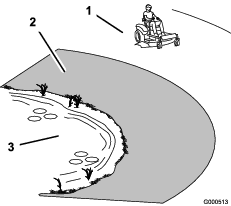
Caution
This machine produces sound levels in excess of 85 dBA at the operator’s ear and can cause hearing loss through extended periods of exposure.
Wear hearing protection when operating this machine.
Use protective equipment for your eyes, ears, hands, feet, and head.

Using the Safety-Interlock System
Warning
If the safety-interlock switches are disconnected or damaged, the machine could operate unexpectedly, causing personal injury.
-
Do not tamper with the interlock switches.
-
Check the operation of the interlock switches daily and replace any damaged switches before operating the machine.
Understanding the Safety-Interlock System
The safety-interlock system is designed to prevent the engine from starting unless:
-
The blade-control switch (PTO) is disengaged.
-
The motion-control levers are in the PARK position.
The safety-interlock system also is designed to shut off the engine whenever the control levers are out of the PARK position and you rise from the seat.
Testing the Safety-Interlock System
Test the safety-interlock system before you use the machine each time. If the safety system does not operate as described below, have an Authorized Service Dealer repair the safety system immediately.
-
Sit on the seat, move the motion-control levers in the PARK position, and move the blade-control switch to the ON position. Try starting the engine; the engine should not crank.
-
Sit on the seat and move the blade-control switch to the OFF position. Move either motion-control lever to the center, unlocked position. Try starting the engine; the engine should not crank. Repeat with the other motion-control lever.
-
Sit on the seat, move the blade-control switch to the OFF position, and lock the motion-control levers in the PARK position. Start the engine. While the engine is running, engage the blade-control switch, and rise slightly from the seat; the engine should shut off.
-
Sit on the seat, move the blade-control switch to the OFF position, and lock the motion-control levers in the PARK position. Start the engine. While the engine is running, move the motion-control levers to the center, unlocked position, engage the blade-control switch, and rise slightly from the seat; the engine should shut off.
Positioning the Seat
The seat can move forward and backward. Position the seat where you have the best control of the machine and are most comfortable (Figure 10).
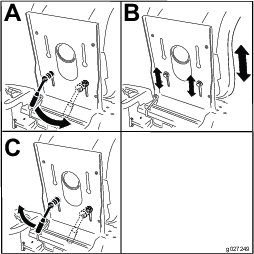
Adjusting the Motion-Control Levers
Adjusting the Height
You can adjust the motion-control levers higher or lower for maximum comfort (Figure 11).
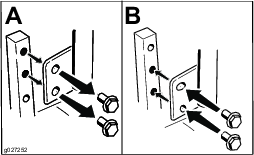
Adjusting the Tilt
You can adjust the motion-control levers forward or rearward for your comfort.
-
Loosen the upper bolt holding the control lever to the control-arm shaft.
-
Loosen the lower bolt just enough to pivot the control lever forward or rearward (Figure 11).
-
Tighten both bolts to secure the control lever in the new position.
-
Repeat the adjustment for the other control lever.
During Operation
During Operation Safety
General Safety
-
The owner/operator can prevent and is responsible for accidents that may cause personal injury or property damage.
-
Wear appropriate clothing, including eye protection; slip-resistant, substantial footwear; and hearing protection. Tie back long hair and do not wear jewelry.
-
Do not operate the machine while ill, tired, or under the influence of alcohol or drugs.
-
Never carry passengers on the machine and keep bystanders and pets away from the machine during operation.
-
Operate the machine only in good visibility to avoid holes or hidden hazards.
-
Avoid mowing on wet grass. Reduced traction could cause the machine to slide.
-
Ensure that all drives are in neutral, the parking brake is engaged, and you are in the operating position before you start the engine.
-
Keep your hands and feet away from the cutting units. Keep clear of the discharge opening at all times.
-
Look behind and down before backing up to be sure of a clear path.
-
Use care when approaching blind corners, shrubs, trees, or other objects that may obscure your vision.
-
Do not mow near drop-offs, ditches, or embankments. The machine could suddenly roll over if a wheel goes over the edge or if the edge gives way.
-
Stop the blades whenever you are not mowing.
-
Stop the machine and inspect the blades after striking an object or if there is an abnormal vibration in the machine. Make all necessary repairs before resuming operation.
-
Slow down and use caution when making turns and crossing roads and sidewalks with the machine. Always yield the right-of-way.
-
Disengage the drive to the cutting unit and shut off the engine before adjusting the height of cut (unless you can adjust it from the operating position).
-
Never run an engine in an area where exhaust gases are enclosed.
-
Never leave a running machine unattended.
-
Before leaving the operating position (including to empty the catchers or to unclog the chute), do the following:
-
Stop the machine on level ground.
-
Disengage the power take-off and lower the attachments.
-
Engage the parking brake.
-
Shut off the engine and remove the key.
-
Wait for all moving parts to stop.
-
-
Do not operate the machine when there is the risk of lightning.
-
Do not use the machine as a towing vehicle.
-
Do not change the governor speed or overspeed the engine.
-
Use accessories and attachments approved by Toro only.
Slope Safety
-
Establish your own procedures and rules for operating on slopes. These procedures must include surveying the site to determine which slopes are safe for machine operation. Always use common sense and good judgment when performing this survey.
-
Slopes are a major factor related to loss-of-control and tip-over accidents, which can result in severe injury or death. Operating the machine on any slope requires extra caution.
-
Operate the machine at a lower speed when you are on a slope.
-
If you feel uneasy operating the machine on a slope, do not do it.
-
Watch for holes, ruts, bumps, rocks, or other hidden objects. Uneven terrain could overturn the machine. Tall grass can hide obstacles.
-
Choose a low ground speed so you will not have to stop or shift while on a slope.
-
A rollover can occur before the tires lose traction.
-
Avoid operating the machine on wet grass. Tires may lose traction; regardless if the brakes are available and functioning.
-
Avoid starting, stopping, or turning the machine on a slope.
-
Keep all movement on slopes slow and gradual. Do not suddenly change the speed or direction of the machine.
-
Do not operate the machine near drop-offs, ditches, embankments, or bodies of water. The machine could suddenly roll over if a wheel goes over the edge or the edge caves in. Establish a safety area between the machine and any hazard (2 machine widths).
-
A 2-post ROPS (Rollover Protection System) is available for the machine as an accessory. A ROPS is recommended if you will be mowing next to drop-offs, near water, or on steep banks which could result in a rollover. Contact an Authorized Service Dealer for more details. The California Code of Regulations requires ROPS (if available) on all mowers used commercially effective March 1, 2011.
Operating the Mower Blade-Control Switch (PTO)
The blade-control switch (PTO) starts and stops the mower blades and any powered attachments.
Engaging the Blade-Control Switch (PTO)
Disengaging the Blade-Control Switch (PTO)

Operating the Throttle
You can move the throttle control between the FAST and SLOW positions (Figure 15).
Always use the FAST position when turning on the mower deck with the blade-control switch (PTO).

Operating the Ignition Switch
-
Turn the ignition key to the START position (Figure 16).
Note: When the engine starts, release the key.
Important: Do not engage the starter for more than 5 seconds at a time. If the engine fails to start, wait 15 seconds between attempts. Failure to follow these instructions can burn out the starter motor.
Note: You may need multiple attempts to start the engine when you start it the first time after the fuel system has been without fuel completely.
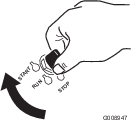
-
Turn the ignition key to the STOP position to shut off the engine.
Starting the Engine
Note: A warm or hot engine may not require choking.
Important: Do not engage the starter for more than 5 seconds at a time. Engaging the starter motor for more than 5 seconds can damage the starter motor. If the engine fails to start, wait 10 seconds before operating the engine starter again.
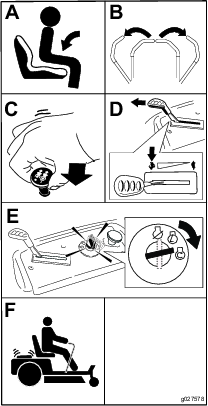
Shutting Off the Engine
-
Disengage the blades by moving the blade-control switch to the OFF position (Figure 14).
-
Engage the parking brake; refer to Park Position.
-
Move the throttle lever to between the half and full throttle position.
-
Turn the key to the OFF position and remove the key.
Caution
Children or bystanders may be injured if they move or attempt to operate the machine while it is unattended.
Always remove the key and engage the parking brake when leaving the machine unattended.
Using the Motion-Control Levers
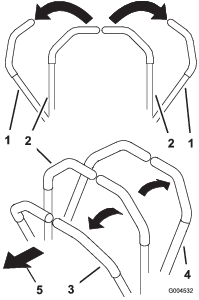
Driving the Machine
The drive wheels turn independently, powered by hydraulic motors on each axle. You can turn 1 side in reverse while you turn the other forward, causing the machine to spin rather than turn. This greatly improves the machine maneuverability but may require sometime for you to adapt to how it moves.
The throttle control regulates the engine speed as measured in rpm (revolutions per minute). Place the throttle control in the FAST position for best performance. Always operate in the full throttle position when mowing.
Warning
The machine can spin very rapidly. You may lose control of the machine and cause personal injury or damage to the machine.
-
Use caution when making turns.
-
Slow the machine down before making sharp turns.
Driving Forward
Note: Always use caution when backing up and turning.
-
Move the levers to the center, unlocked position.
-
To go forward, slowly push the motion-control levers forward (Figure 19).
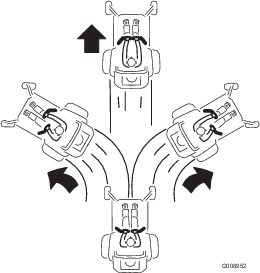
Driving Backward
-
Move the levers to the center, unlocked position.
-
To go backward, slowly pull the motion-control levers rearward (Figure 20).
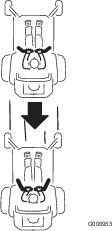
Using the Smart Speed
The Smart Speed TM Control-System lever, located below the operating position (Figure 21), gives the operator a choice to drive the machine at 3 ground speed ranges—trim, tow, and mow.
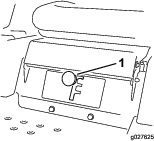
To change speeds, do the following:
-
Move the motion-control levers to neutral and outward to the PARK position.
-
Disengage the blade-control switch.
-
Adjust the lever to the desired position.
The following are only recommendations for use. Adjustments vary by grass type, moisture content, and the height of the grass.
| Suggested uses: | Trim | Tow | Mow |
| Parking | X | ||
| Heavy, wet grass | X | ||
| Training | X | ||
| Bagging | X | ||
| Mulching | X | ||
| Normal mowing | X | ||
| Transport | X |
Trim
This is the lowest speed. The suggested uses for this speed are as follows:
-
Parking
-
Heavy, wet grass mowing conditions
-
Training
Tow
This is the medium speed. The suggested uses for this speed are as follows:
-
Bagging
-
Mulching
Mow
This is the fastest speed. The suggested uses for this speed are as follows:
-
Normal mowing
-
Transporting the machine
Stopping the Machine
To stop the machine, move the motion-control levers to NEUTRAL and outward to the PARK position, disengage the blade-control switch, ensure that the throttle is in the FAST position, and turn the ignition key to OFF. Remove the key from the ignition switch.
Warning
Children or bystanders may be injured if they move or attempt to operate the machine while it is unattended.
Always remove the ignition key and move the motion-control levers outward to the PARK position when leaving the machine unattended, even if just for a few minutes.
Adjusting the Height of Cut
Note: The transport position is the highest height-of-cut position at 115 mm (4-1/2 inches) as shown in Figure 22.
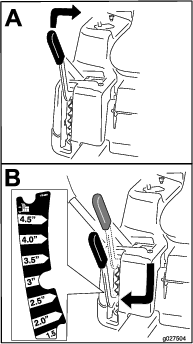
Adjusting the Anti-Scalp Rollers
Machines with a 42-inch or 50-inch Deck Only
Whenever you change the height of cut, adjust the height of the anti-scalp rollers.
Note: Adjust the anti-scalp rollers so that the rollers do not touch the ground in normal, flat mowing areas.
-
Disengage the blade-control switch (PTO), move the motion-control levers to the PARK position, and engage the parking brake.
-
Shut off the engine, remove the key, and wait for all moving parts to stop before leaving the operating position.
-
Adjust the anti-scalp rollers as shown in Figure 23 to match the closest height-of-cut position.
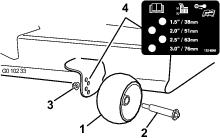
Operating Tips
Using the Fast Throttle Setting
For best mowing and maximum air circulation, operate the engine at the FAST position. Air is required to thoroughly cut grass clippings, so do not set the height-of-cut so low as to totally surround the mower in uncut grass. Always try to have 1 side of the mower free from uncut grass, which allows air to be drawn into the mower.
Cutting a Lawn for the First Time
Cut grass slightly longer than normal to ensure that the cutting height of the mower does not scalp any uneven ground. However, the cutting height used in the past is generally the best one to use. When cutting grass longer than 15 cm (6 inches) tall, you may want to cut the lawn twice to ensure an acceptable quality of cut.
Cutting a Third of the Grass Blade
It is best to cut only about a third of the grass blade. Cutting more than that is not recommended unless grass is sparse, or it is late fall when grass grows more slowly.
Alternating the Mowing Direction
Alternate the mowing direction to keep the grass standing straight. This also helps disperse clippings which enhances decomposition and fertilization.
Mowing at Correct Intervals
Grass grows at different rates at different times of the year. To maintain the same cutting height, mow more often in early spring. As the grass growth rate slows in mid summer, mow less frequently. If you cannot mow for an extended period, first mow at a high cutting height, then mow again 2 days later at a lower height setting.
Using a Slower Cutting Speed
To improve cut quality, use a slower ground speed in certain conditions.
Avoiding Cutting Too Low
When mowing uneven turf, raise the cutting height to avoid scalping the turf.
Stopping the Machine
If you must stop the forward motion of the machine while mowing, a clump of grass clippings may drop onto your lawn. To avoid this, move onto a previously cut area with the blades engaged or you can disengage the mower deck while moving forward.
Keeping the Underside of the Mower Clean
Clean clippings and dirt from the underside of the mower after each use. If grass and dirt build up inside the mower, cutting quality will eventually become unsatisfactory.
Maintaining the Blade(s)
Maintain a sharp blade throughout the cutting season because a sharp blade cuts cleanly without tearing or shredding the grass blades. Tearing and shredding turns grass brown at the edges, which slows growth and increases the chance of disease. Check the mower blades after each use for sharpness, and for any wear or damage. File down any nicks and sharpen the blades as necessary. If a blade is damaged or worn, replace it immediately with a genuine Toro replacement blade.
After Operation
After Operation Safety
General Safety
-
Clean grass and debris from the cutting units, mufflers, and engine compartment to help prevent fires. Clean up oil or fuel spills.
-
Shut off the fuel before storing or transporting the machine.
-
Disengage the drive to the attachment whenever you are transporting or not using the machine.
-
Use full-width ramps for loading the machine into a trailer or truck.
-
Tie the machine down securely using straps, chains, cable, or ropes. Both front and rear straps should be directed down and outward from the machine.
-
Allow the engine to cool before storing the machine in any enclosure.
-
Shut off the fuel before storing or transporting the machine.
-
Never store the machine or fuel container where there is an open flame, spark, or pilot light, such as on a water heater or on other appliances.
Pushing the Machine by Hand
Important: Always push the machine by hand. Do not tow the machine, because damage to the hydraulic drive system may occur.
This machine has an electric-brake mechanism. To push the machine, turn the ignition key to the RUN position. The battery must be charged and functioning to disengage the electric brake.
Pushing the Machine
-
Park the machine on a level surface and disengage the blade-control switch.
-
Move the motion-control levers outward to the PARK position, shut off the engine, and wait for all moving parts to stop before leaving the operating position.
-
Locate the bypass levers on the frame on both sides of the engine.
-
Move the bypass levers forward through the key hole and down to lock them in place (Figure 24).
Note: Do this for each lever.
-
Move the motion-control levers inward to the NEUTRAL position and turn the ignition key to the RUN position.
Note: Do not start the machine.
Note: You can now push the machine by hand.
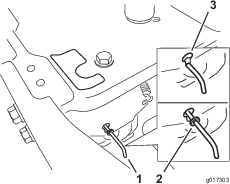
-
When finished, turn the key to the STOP position to avoid draining the battery charge.
Note: If the machine fails to move, the electric brake may still be engaged. You can release the electric brake if necessary; refer to Releasing the Electric Brake.
Operating the Machine
Move the bypass levers rearward through the key hole and down to lock them in place as shown in Figure 24.
Note: Do this for each lever.
Transporting the Machine
Use a heavy-duty trailer or truck to transport the machine. Ensure that the trailer or truck has all necessary brakes, lighting, and marking as required by law. Please carefully read all the safety instructions. Knowing this information could help you, your family, pets, or bystanders avoid injury.
Warning
Driving on the street or roadway without turn signals, lights, reflective markings, or a slow-moving-vehicle emblem is dangerous and can lead to accidents, causing personal injury.
Do not drive the machine on a public street or roadway.
-
If you are using a trailer, connect it to the towing vehicle and connect the safety chains.
-
If applicable, connect the trailer brakes.
-
Load the machine onto the trailer or truck.
-
Shut off the engine, remove the key, set the brake, and close the fuel valve.
-
Tie down the machine near the front caster wheels and the rear bumper (Figure 25).
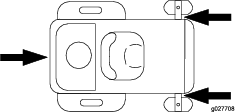
Loading the Machine
Use extreme caution when loading or unloading machines onto a trailer or a truck. Use a full-width ramp that is wider than the machine for this procedure. Back up the ramp and drive forward down the ramp (Figure 26).

Important: Do not use narrow individual ramps for each side of the machine.
Warning
Loading a machine onto a trailer or truck increases the possibility of tip-over and could cause serious injury or death (Figure 27).
-
Use extreme caution when operating a machine on a ramp.
-
Use only a full-width ramp; do not use individual ramps for each side of the machine.
-
Do not exceed a 15-degree angle between the ramp and the ground or between the ramp and the trailer or truck.
-
Ensure that the length of ramp is at least 4 times as long as the height of the trailer or truck bed to the ground. This ensures that the ramp angle does not exceed 15 degrees on flat ground.
-
Back up ramps and drive forward down ramps.
-
Avoid sudden acceleration or deceleration while driving the machine on a ramp as this could cause a loss of control or a tip-over situation.
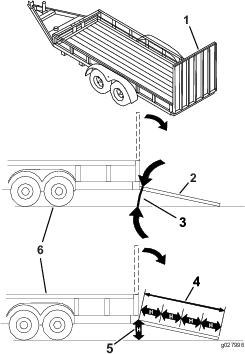
Maintenance
Note: Determine the left and right sides of the machine from the normal operating position.
Recommended Maintenance Schedule(s)
| Maintenance Service Interval | Maintenance Procedure |
|---|---|
| Before each use or daily |
|
| After each use |
|
| Every 25 hours |
|
| Every 50 hours |
|
| Every 100 hours |
|
| Every 200 hours |
|
| Every 500 hours |
|
| Before storage |
|
Important: Refer to your engine owner's manual for additional maintenance procedures.
Caution
If you leave the key in the ignition switch, someone could accidently start the engine and seriously injure you or other bystanders.
Remove the key from the ignition and disconnect the wire from the spark plug before you do any maintenance. Set the wire aside so that it does not accidentally contact the spark plug.
Pre-Maintenance Procedures
Maintenance and Storage
-
Before repairing the machine do the following:
-
Disengage the drives.
-
Engage the parking brake.
-
Shut off the engine and remove the key.
-
Disconnect the spark-plug wire.
-
-
Park the machine on a level surface.
-
Clean grass and debris from the cutting unit, drives, mufflers, and engine to help prevent fires.
-
Clean up oil or fuel spills.
-
Let the engine cool before storing the machine.
-
Do not store the machine or fuel near flames or drain the fuel indoors.
-
Do not allow untrained personnel to service the machine.
-
Use jack stands to support the machine and/or components when required.
-
Carefully release pressure from components with stored energy.
-
Disconnect the battery or remove the spark-plug wire before making any repairs. Disconnect the negative terminal first and the positive terminal last. Connect the positive terminal first and negative last.
-
Use care when checking the blades. Wrap the blade(s) or wear thickly padded gloves, and use caution when servicing them. Only replace blades; do not straighten or weld them.
-
Keep your hands and feet away from moving parts. If possible, do not make adjustments with the engine running.
-
Keep all parts in good working condition and all hardware tightened, especially the blade-attachment bolts. Replace all worn or damaged decals.
-
Never interfere with the intended function of a safety device or reduce the protection provided by a safety device. Check their proper operation regularly.
-
To ensure optimum performance and continued safety certification of the machine, use only genuine Toro replacement parts and accessories. Replacement parts and accessories made by other manufacturers could be dangerous, and such use could void the product warranty.
-
Check the parking brake operation frequently. Adjust and service as required.
Raising the Seat
Make sure that the motion-control levers are locked in the PARK position. Lift the seat forward.
You can access the following components by raising the seat:
-
Serial plate
-
Service decal
-
Seat-adjustment bolts
-
Fuel filter
-
Battery and battery cables
Lubrication
Greasing the Bearings
| Maintenance Service Interval | Maintenance Procedure |
|---|---|
| Every 25 hours |
|
Grease Type: No. 2 lithium grease
-
Park the machine on a level surface and disengage the blade-control switch.
-
Move the motion-control levers outward to the PARK position, shut off the engine, remove the key, and wait for all moving parts to stop before leaving the operating position.
-
Clean the grease fittings (Figure 28 and Figure 29) with a rag.
Note: Make sure to scrape any paint off the front of the fitting(s).


-
Connect a grease gun to each fitting (Figure 28 and Figure 29).
-
Pump grease into the fittings until grease begins to ooze out of the bearings.
Engine Maintenance
Engine Safety
Shut off the engine before checking the oil or adding oil to the crankcase.
Servicing the Air Cleaner
| Maintenance Service Interval | Maintenance Procedure |
|---|---|
| Before each use or daily |
|
| Every 50 hours |
|
| Every 100 hours |
|
This engine is equipped with a replaceable, high-density paper air-cleaner element. Check the air cleaner daily or before starting the engine. Check for a buildup of dirt and debris around the air-cleaner system. Keep this area clean. Also, check for loose or damaged components. Replace all bent or damaged air-cleaner components.
Note: Operating the engine with loose or damaged air-cleaner components could allow unfiltered air into the engine, causing premature wear and failure.
-
Rotate the latches outward.
-
Remove the cover to access the air-cleaner element ().
-
Remove the element, and gently tap the element to dislodge dirt.
Note: Do not wash the paper element or use pressurized air, as this will damage the element.
Note: Replace a dirty, bent, or damaged element. Handle the new element carefully; do not use if the sealing surfaces are bent or damaged.
-
Clean the air-cleaner base as required and check the condition.
-
Install the paper element onto the air-cleaner base.
-
Install the cover and secure it with the latches (Figure 30).

Servicing the Engine Oil
Oil Type: Detergent oil (API service SJ or higher)
Crankcase Capacity: 1.9 L (64 oz) with the oil filter
Viscosity: See the table below.
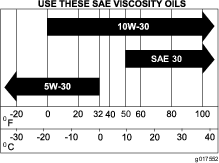
Checking the Engine-Oil Level
| Maintenance Service Interval | Maintenance Procedure |
|---|---|
| Before each use or daily |
|
-
Park the machine on a level surface, disengage the blade-control switch, shut off the engine, and remove the key.
-
Make sure that the engine is stopped, level, and cool so the oil has time to drain into the sump.
-
Check the engine-oil level (Figure 32).
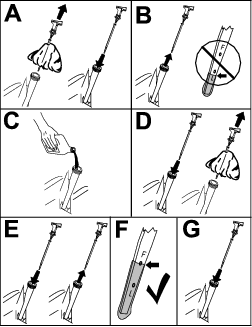
Changing the Engine Oil and the Engine-Oil Filter
| Maintenance Service Interval | Maintenance Procedure |
|---|---|
| Every 100 hours |
|
Note: The drain plug is attached to the drain hose.
Note: Dispose the used oil at a recycling center.
Fill with oil as specified in the table shown in Figure 31.
-
Park the machine so that the drain side is slightly lower than the opposite side to ensure that the oil drains completely.
-
Disengage the blade-control switch and move the motion-control levers outward to the PARK position.
-
Shut off the engine, remove the key, and wait for all moving parts to stop before leaving the operating position.
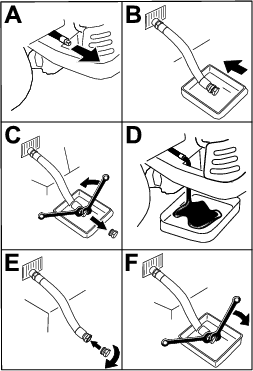
-
Torque the plug to 14 N·m (125 in-lb).
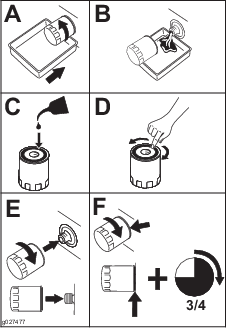
-
Slowly pour approximately 80% of the specified oil into the filler tube (Figure 35).
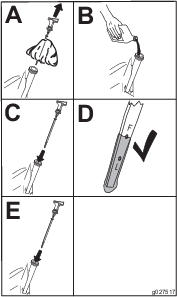
Servicing the Spark Plug
| Maintenance Service Interval | Maintenance Procedure |
|---|---|
| Every 200 hours |
|
| Every 500 hours |
|
Type: Champion XC12YC or equivalent that is RFI compliant
Air Gap: 0.76 mm (0.03 inch)
Removing the Spark Plug
-
Disengage the blade-control switch, move the motion-control levers outward to the PARK position, shut off the engine, and remove the key.
-
Before removing the spark plug(s), clean the area around the base of the plug to keep dirt and debris out of the engine.
-
Remove the spark plug (Figure 36).
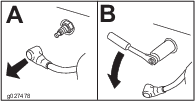
Checking the Spark Plug
Important: Do not clean the spark plug(s). Always replace the spark plug(s) when it has: a black coating, worn electrodes, an oily film, or cracks.
Note: If you see light brown or gray on the insulator, the engine is operating properly. A black coating on the insulator usually means that the air cleaner is dirty.
Set the gap to 0.76 mm (0.030 inch).
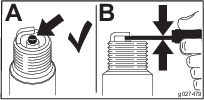
Installing the Spark Plug
Tighten the spark plug to 25 to 29 N·m (18 to 22 ft-lb).

Cleaning the Blower Housing
| Maintenance Service Interval | Maintenance Procedure |
|---|---|
| Every 100 hours |
|
To ensure proper cooling, make sure that the grass screen, cooling fins, and other external surfaces of the engine are kept clean at all times.
Clean the cooling fins and external surfaces as necessary. Make sure that the cooling shrouds are installed. Torque the blower housing screws to 7.5 N·m (5.5 ft-lb).
Important: Operating the engine with a blocked grass screen, dirty or plugged cooling fins, and/or cooling shrouds removed, causes engine damage due to overheating.
Fuel System Maintenance
Danger
In certain conditions, fuel is extremely flammable and highly explosive. A fire or explosion from fuel can burn you, others, and can damage property.
-
Perform any fuel-related maintenance when the engine is cold. Do this outdoors in an open area. Wipe up any fuel that spills.
-
Never smoke when draining fuel, and stay away from an open flame or where a spark may ignite the fuel fumes.
Replacing the In-Line Fuel Filter
| Maintenance Service Interval | Maintenance Procedure |
|---|---|
| Every 100 hours |
|
Never install a dirty filter if it is removed from the fuel line.
-
Park the machine on a level surface and disengage the blade-control switch.
-
Move the motion-control levers outward to the PARK position, shut off the engine, remove the key, and wait for all moving parts to stop before leaving the operating position.
-
Replace the in-line filter (Figure 39).
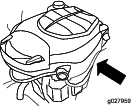
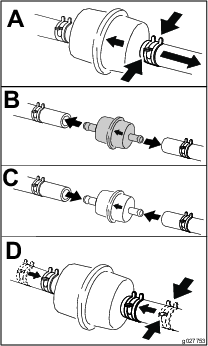
Electrical System Maintenance
Electrical System Safety
-
Disconnect the battery before repairing the machine. Disconnect the negative terminal first and the positive last. Connect the positive terminal first and the negative last.
-
Charge the battery in an open, well-ventilated area, away from sparks and flames. Unplug the charger before connecting or disconnecting the battery. Wear protective clothing and use insulated tools.
Warning
Battery posts, terminals, and related accessories contain lead and lead compounds, chemicals known to the State of California to cause cancer and reproductive harm. Wash hands after handling.
Charging the Battery
Removing the Battery
Warning
Battery terminals or metal tools could short against metal machine components, causing sparks. Sparks can cause the battery gasses to explode, resulting in personal injury.
-
When removing or installing the battery, do not allow the battery terminals to touch any metal parts of the machine.
-
Do not allow metal tools to short between the battery terminals and metal parts of the machine.
-
Park the machine on a level surface and disengage the blade-control switch.
-
Move the motion-control levers outward to the PARK position, shut off the engine, remove the key, and wait for all moving parts to stop before leaving the operating position.
-
Raise the seat to access the battery.
-
Disconnect the negative (black) ground cable from the battery post (Figure 40).
Note: Retain all fasteners.
Warning
Incorrect battery-cable routing could damage the machine and cables causing sparks. Sparks can cause the battery gasses to explode, resulting in personal injury.
-
Always disconnect the negative (black) battery cable before disconnecting the positive (red) cable.
-
Always connect the positive (red) battery cable before connecting the negative (black) cable.
-
-
Slide the rubber cover up the positive (red) cable.
-
Disconnect the positive (red) cable from the battery post (Figure 40).
Note: Retain all fasteners.
-
Remove the battery hold-down and lift the battery from the battery tray (Figure 40).
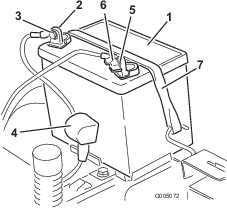
Charging the Battery
| Maintenance Service Interval | Maintenance Procedure |
|---|---|
| Before storage |
|
-
Remove the battery from the chassis; refer to Removing the Battery.
-
Charge the battery for a minimum of 1 hour at 6 to 10 A.
Note: Do not overcharge the battery.
-
When the battery is fully charged, unplug the charger from the electrical outlet, then disconnect the charger leads from the battery posts (Figure 41).
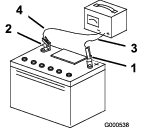
Installing the Battery
-
Position the battery in the tray (Figure 40).
-
Using the fasteners previously removed, install the positive (red) battery cable to the positive (+) battery terminal.
-
Using the fasteners previously removed, install the negative battery cable to the negative (-) battery terminal.
-
Slide the red terminal boot onto the positive (red) battery post.
-
Secure the battery with the hold-down (Figure 40).
-
Lower the seat.
Servicing the Fuses
The electrical system is protected by fuses. It requires no maintenance; however, if a fuse blows, check the component/circuit for a malfunction or short.
Fuse type:
-
Main—F1 (30 A, blade-type)
-
Charge Circuit—F2 (25 A, blade-type)
-
Remove the screws securing the control panel to the machine.
Note: Retain all fasteners.
-
Lift the control pane up to access the main wire harness and fuse block (Figure 42).
-
To replace a fuse, pull out on the fuse to remove it (Figure 42).
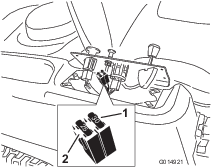
-
Return the control panel to its original position.
Note: Use the screws removed previously to secure the panel to the machine.
Drive System Maintenance
Checking the Tire Pressure
| Maintenance Service Interval | Maintenance Procedure |
|---|---|
| Every 25 hours |
|
Maintain the air pressure in the front and rear tires as specified. Uneven tire pressure can cause uneven cut. Check the pressure at the valve stem (Figure 43). Check the tires when they are cold to get the most accurate pressure reading.
Refer to the maximum pressure suggested by the tire manufacturer on the sidewall of the caster wheel tires.
Inflate the rear drive wheel tires to 90 kPa (13 psi).

Releasing the Electric Brake
You can manually disengage the electric brake by rotating the link arms forward. Once the electric brake is energized, the brake engages again.
-
Turn the ignition key to the OFF position or disconnect the battery.
-
Locate the shaft on the electric brake where the brake link arms are connected (Figure 44).
-
Rotate the shaft forward to release the brake.
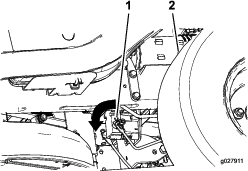
Mower Maintenance
Servicing the Cutting Blades
To ensure a superior quality of cut, keep the blades sharp. For convenient sharpening and replacement, keep extra blades on hand.
Blade Safety
A worn or damaged blade can break, and a piece of the blade could be thrown toward you or bystanders, resulting in serious personal injury or death. Trying to repair a damaged blade may result in discontinued safety certification of the product.
-
Inspect the blades periodically for wear or damage.
-
Use care when checking the blades. Wrap the blades or wear gloves, and use caution when servicing the blades. Only replace or sharpen the blades; never straighten or weld them.
-
On multi-bladed machines, take care as rotating 1 blade can cause other blades to rotate.
Before Inspecting or Servicing the Blades
-
Park the machine on a level surface, disengage the blade-control switch (PTO), and move the motion-control levers outward to the PARK position.
-
Shut off the engine, remove the key, and disconnect the spark-plug wires from the spark plugs.
Inspecting the Blades
| Maintenance Service Interval | Maintenance Procedure |
|---|---|
| Before each use or daily |
|
-
Inspect the cutting edges (Figure 45).
-
If the edges are not sharp or have nicks, remove and sharpen the blade; refer to Sharpening the Blades.
-
Inspect the blades, especially in the curved area.
-
If you notice any cracks, wear, or a slot forming in this area, immediately install a new blade (Figure 45).
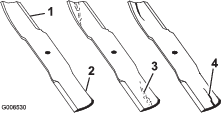
Checking for Bent Blades
Note: The machine must be on a level surface for the following procedure.
-
Raise the mower deck to the highest height-of-cut position.
-
While wearing thickly padded gloves, or other adequate hand protection, slowly rotate the blade to be measure into a position that allows effective measurement of the distance between the cutting edge and the level surface the machine is on (Figure 46).
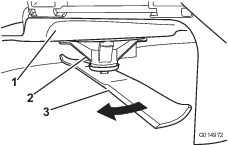
-
Measure from the tip of the blade to the flat surface (Figure 47).
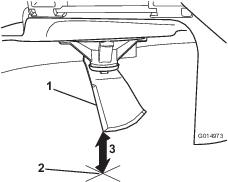
-
Rotate the same blade 180 degrees so that the opposing cutting edge is now in the same position (Figure 48).
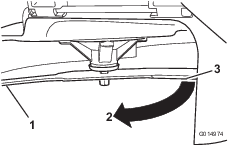
-
Measure from the tip of the blade to the flat surface (Figure 49).
Note: The variance should be no more than 3 mm (1/8 inch).

-
If the difference between A and B is greater than 3 mm (1/8 inch), replace the blade with a new blade; refer to Removing the Blades and Installing the Blades.
Note: If a bent blade is replaced with a new blade, and the dimension obtained continues to exceed 3 mm (1/8 inch), the blade spindle could be bent. Contact an Authorized Service Dealer for service.
-
If the variance is within constraints, move to the next blade.
-
-
Repeat this procedure on each blade.
Removing the Blades
Replace the blades if they hit a solid object, or if the blade is out of balance or bent.
-
Hold the blade end using a rag or thickly padded glove.
-
Remove the blade bolt, curved washer, and blade from the spindle shaft (Figure 50).
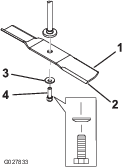
Sharpening the Blades
-
Use a file to sharpen the cutting edge at both ends of the blade (Figure 51).
Note: Maintain the original angle.
Note: The blade retains its balance if the same amount of material is removed from both cutting edges.

-
Check the balance of the blade by putting it on a blade balancer (Figure 52).
Note: If the blade stays in a horizontal position, the blade is balanced and can be used.
Note: If the blade is not balanced, file some metal off the end of the sail area only (Figure 51).

-
Repeat this procedure until the blade is balanced.
Installing the Blades
-
Install the blade onto the spindle shaft (Figure 50).
Important: The curved part of the blade must point upward toward the inside of the mower to ensure proper cutting.
-
Install the curved washer (cupped side toward the blade) and the blade bolt (Figure 50).
-
Torque the blade bolt to 47 to 88 N∙m (35 to 65 ft-lb).
Leveling the Mower Deck
Check to ensure that the mower deck is level any time you install the mower or when you see an uneven cut on your lawn.
Check the mower deck for bent blades prior to leveling, and remove and replace any bent blades; refer to the Checking for Bent Blades before continuing.
Level the mower deck side-to-side first; then you can adjust the front-to-rear slope.
Requirements:
-
The machine must be on a level surface.
-
All tires must be properly inflated; refer to Checking the Tire Pressure.
Leveling from Side to Side
-
Park the machine on a level surface and disengage the blade-control switch.
-
Move the motion-control levers outward to the PARK position, shut off the engine, remove the key, and wait for all moving parts to stop before leaving the operating position.
-
Set the height-of-cut lever to middle position.
-
Carefully rotate the blades so that they are all side to side (Figure 53 and Figure 54).
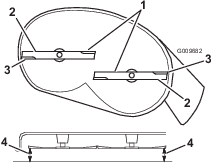
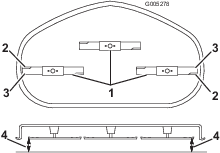
-
Measure between the outside cutting edges and the flat surface (Figure 53 and Figure 54).
Note: If both measurements are not within 5 mm (3/16 inch), an adjustment is required; continue with this procedure.
-
Move to the left side of the machine.
-
Loosen the side locking nut.
-
Raise or lower the left side of the mower deck by rotating the rear nut (Figure 55).
Note: Rotate the rear nut clockwise to raise the mower deck; rotate the rear nut counter-clockwise to lower the mower deck. (Figure 55).

-
Check the side-to-side adjustments again. Repeat this procedure until the measurements are correct.
-
Continue leveling the mower deck by checking the front-to-rear blade slope; refer to Adjusting the Front-to-Rear Blade Slope.
Adjusting the Front-to-Rear Blade Slope
Check the front-to-rear blade level any time you install the mower. If the front of the mower is more than 7.9 mm (5/16 inch) lower than the rear of the mower, adjust the blade level using the following instructions:
-
Park the machine on a level surface and disengage the blade-control switch.
-
Move the motion-control levers outward to the PARK position, shut off the engine, remove the key, and wait for all moving parts to stop before leaving the operating position.
-
Set the height-of-cut lever to middle position.
Note: Check and adjust the side-to-side blade level if you have not checked the setting; refer to Leveling from Side to Side.
-
Carefully rotate the blades so they are facing front to rear (Figure 56 and Figure 57).
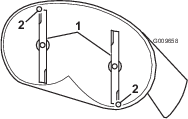
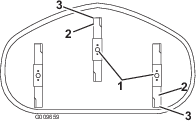
-
Measure from the tip of the front blade to the flat surface, and the tip of the rear blade to the flat surface (Figure 56 and Figure 57).
Note: If the front blade tip is not 1.6 to 7.9 mm (1/16 to 5/16 inch) lower than the rear blade tip, adjust the front locknut.
-
To adjust the front-to-rear blade slope, rotate the adjustment nut in the front of the mower (Figure 58).
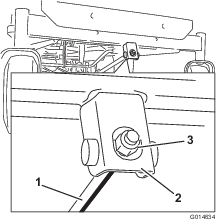
-
To raise the front of the mower, tighten the adjustment nut.
-
To lower the front of the mower, loosen the adjustment nut.
-
After adjustment, check the front-to-rear slope again, continue adjusting the nut until the front blade tip is 1.6 to 7.9 mm (1/16 to 5/16 inch) lower than the rear blade tip (Figure 56 and Figure 57).
-
When the front-to-rear blade slope is correct check the side-to-side level of the mower again, refer to Leveling from Side to Side.
Removing the Mower Deck
-
Park the machine on a level surface and disengage the blade-control switch.
-
Move the motion-control levers outward to the PARK position, shut off the engine, remove the key, and wait for all moving parts to stop before leaving the operating position.
-
Lower the height-of-cut lever to the lowest position.
-
Remove the hairpin-cotter pin from the front support rod, and remove the rod from the deck bracket (Figure 59).
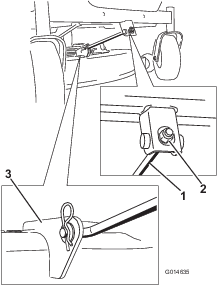
-
Carefully lower the front of the mower deck to the ground.
-
Lift the mower deck and hanger brackets clear of the rear lift rod and lower the mower carefully to the ground (Figure 60).
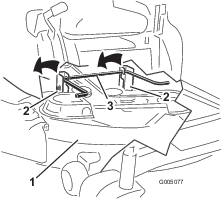
-
Slide the mower deck rearward to remove the mower belt from the engine pulley.
-
Slide the mower deck out from underneath the machine.
Note: Retain all parts for future installation.
Installing the Mower
-
Park the machine on a level surface and disengage the blade-control switch.
-
Move the motion-control levers outward to the PARK position, shut off the engine, remove the key, and wait for all moving parts to stop before leaving the operating position.
-
Slide the mower under the machine.
-
Lower the height-of-cut lever to the lowest position.
-
Lift the rear of the mower deck and guide the hanger brackets over the rear lift rod (Figure 60).
-
Attach the front support rod to the mower deck with the clevis pin and hairpin cotter (Figure 59).
-
Install the mower belt onto the engine pulley.
Replacing the Grass Deflector
| Maintenance Service Interval | Maintenance Procedure |
|---|---|
| Before each use or daily |
|
Warning
An uncovered discharge opening could allow the machine to throw objects at you or bystanders, resulting in serious injury. Also, contact with the blade could occur. Never operate the machine without the grass deflector, the discharge cover, or the grass-collection system in place.
Never operate the machine without the grass deflector, the discharge cover, or the grass-collection system in place.
Inspect the grass deflector for damage before each use. Replace any damaged parts before use.
-
Remove the nut (3/8 inch) from the rod under the mower (Figure 61).
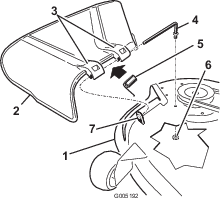
-
Slide the rod out of the short standoff, spring, and the grass deflector (Figure 61).
-
Remove the damaged or worn grass deflector.
-
Replace the grass deflector (Figure 61).
-
Slide the rod (straight end), through the rear-grass-deflector bracket.
-
Place the spring on the rod, with the end wires down and between the grass-deflector brackets.
-
Slide rod through the second grass-deflector bracket (Figure 61).
-
Insert the rod at the front of the grass deflector into the short standoff on the deck.
-
Secure the rear end of the rod into the mower with a nut (3/8 inch) as shown in Figure 61.
Important: The grass deflector must be spring loaded and in the down position. Lift the deflector up to test that it snaps to the fully down position.
Mower Belt Maintenance
Inspecting the Belts
| Maintenance Service Interval | Maintenance Procedure |
|---|---|
| Every 25 hours |
|
Check the belts for cracks, frayed edges, burn marks, or any other damage. Replace damaged belts.
Replacing the Mower Belt
The signs of a worn belt include squealing while the belt is rotating, blades slipping while cutting grass, and frayed edges, burn marks, and cracks on the belt. Replace the mower belt if any of these conditions are evident.
-
Park the machine on a level surface and disengage the blade-control switch.
-
Move the motion-control levers outward to the PARK position, shut off the engine, remove the key, and wait for all moving parts to stop before leaving the operating position.
-
Set the height-of-cut at the lowest cutting position of 38 mm (1-1/2 inches).
-
Remove the pulley covers (Figure 62).

-
Using a spring-removal tool (Toro Part No. 92-5771), remove the idler spring from the deck hook to remove tension on the idler pulley, and roll the belt off the pulleys (Figure 63).
Warning
The spring is under tension when installed and can cause personal injury.
Be careful when removing the belt.

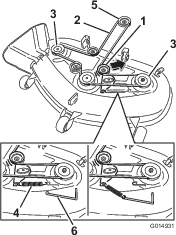
-
Route the new belt around the engine pulley and mower pulleys (Figure 63).
-
Using a spring-removal tool, install the idler spring over the deck hook, and place tension on the idler pulley and mower belt (Figure 63).
-
Install the pulley covers (Figure 62).
Cleaning
Washing the Underside of the Mower
| Maintenance Service Interval | Maintenance Procedure |
|---|---|
| After each use |
|
Important: You can wash the machine with a mild detergent and water. Do not pressure wash the machine. Avoid excessive use of water, especially near the control panel, under the seat, around the engine, hydraulic pumps, and motors.
Wash the underside of the mower after each use to prevent grass buildup for improved mulch action and clipping dispersal.
-
Park the machine on a level surface and disengage the blade-control switch.
-
Move the motion-control levers outward to the PARK position, shut off the engine, remove the key, and wait for all moving parts to stop before leaving the operating position.
-
Attach the hose coupling to the end of the mower washout fitting, and turn the water on high (Figure 65).
Note: Spread petroleum jelly on the washout fitting O-ring to make the coupling slide on easier and protect the O-ring.
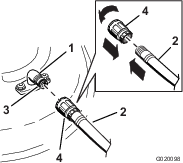
-
Lower the mower to the lowest height-of-cut.
-
Sit on the seat and start the engine.
-
Engage the blade-control switch and let the mower run for 1 to 3 minutes.
-
Disengage the blade-control switch, shut off the engine, remove the ignition key, and wait for all moving parts to stop.
-
Turn the water off and remove the coupling from the washout fitting.
Note: If the mower is not clean after 1 washing, soak it and let it stand for 30 minutes. Then, repeat the process.
-
Run the mower again for 1 to 3 minutes to remove excess water.
Warning
A broken or missing washout fitting could expose you and others to thrown objects or blade contact. Contact with a blade or thrown debris can cause injury or death.
-
Replace broken or missing washout fitting immediately, before using mower again.
-
Never put your hands or feet under the mower or through openings in the mower.
-
Storage
Cleaning and Storage
-
Disengage the blade-control switch, move the motion-control levers outward to the PARK position, shut off the engine, and remove the key.
-
Remove grass clippings, dirt, and grime from the external parts of the entire machine, especially the engine. Clean dirt and chaff from the outside of the engine cylinder head fins and blower housing.
Important: You can wash the machine with mild detergent and water. Do not pressure wash the machine. Avoid excessive use of water, especially near the control panel, under the seat, around the engine, hydraulic pumps, and motors.
-
Service the air cleaner; refer to Servicing the Air Cleaner.
-
Grease and oil the machine; refer to Lubrication.
-
Change the engine oil and filter; refer to Changing the Engine Oil and the Engine-Oil Filter.
-
Check the tire pressure; refer to Checking the Tire Pressure.
-
Charge the battery; refer to Charging the Battery.
-
Check the condition of the blades; refer to Inspecting the Blades.
-
Prepare the machine for storage when non-use occurs over 30 days. Prepare the machine for storage as follows.
-
Add a petroleum based stabilizer/conditioner to the fuel in the tank. Follow the mixing instructions from the stabilizer manufacturer. Do not use an alcohol based stabilizer (ethanol or methanol).
Note: A fuel stabilizer/conditioner is most effective when mixed with fresh gasoline and used at all times.
-
Run the engine to distribute the conditioned fuel through the fuel system (5 minutes).
-
Shut off the engine, wait for it to cool, and drain the fuel tank.
-
Start the engine and run it until it stops.
-
Start and run the engine until it does not start.
-
Dispose of fuel properly. Recycle according to local codes.
Important: Do not store stabilizer/conditioned gasoline over 90 days.
-
-
Remove the spark plug(s) and check its condition; refer to Servicing the Spark Plug. With the spark plug(s) removed from the engine, pour 2 tablespoons of engine oil into the spark plug hole. Use the starter to crank the engine and distribute the oil inside the cylinder. Install the spark plug(s). Do not install the wire on the spark plug(s).
-
Clean any dirt and chaff from the top of the mower.
-
Scrape any heavy buildup of grass and dirt from the underside of the mower, then wash the mower with a garden hose.
-
Check the condition of the drive and mower belts.
-
Check and tighten all bolts, nuts, and screws. Repair or replace any part that is worn or damaged.
-
Paint all scratched or bare metal surfaces. Paint is available from your Authorized Service Dealer.
-
Store the machine in a clean, dry garage or storage area. Remove the key from the ignition switch and keep it in a memorable place. Cover the machine to protect it and keep it clean.
Troubleshooting
| Problem | Possible Cause | Corrective Action |
|---|---|---|
| The engine overheats. |
|
|
| The starter does not crank. |
|
|
| The engine does not start, starts hard, or fails to keep running. |
|
|
| The engine loses power. |
|
|
| The machine does not drive. |
|
|
| There is an abnormal vibration. |
|
|
| The cutting height is uneven. |
|
|
| The blades do not rotate. |
|
|
Schematics
Electrical Diagram
